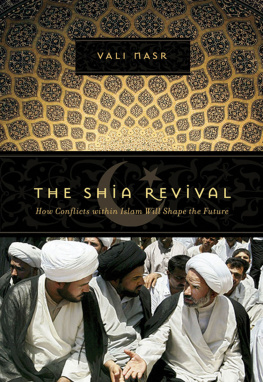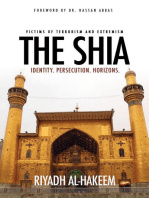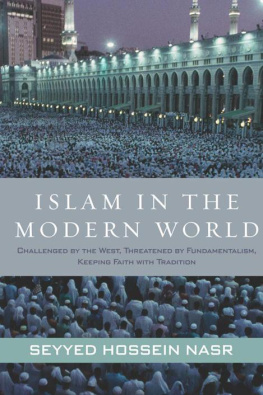VALI NASR
THE SHIA REVIVAL
How Conflicts within Islam Will Shape the Future

W. W. Norton & Company
New York London
Copyright 2006 by Vali Nasr
All rights reserved
For information about permission to reproduce selections from this book, write to Permissions, W. W. Norton & Company, Inc., 500 Fifth Avenue, New York, NY 10110
Library of Congress Cataloging-in-Publication Data
Nasr, Seyyed Vali Reza, 1960
The Shia revival: how conflicts within Islam will shape the future / Vali Nasr.1st ed.
p. cm.
Includes bibliographical references.
ISBN: 978-0-393-32968-1
1. Sh ahPolitical aspectsMiddle East. 2. Islam and politicsMiddle EastHistory20th century. 3. Middle EastPolitics and government1979. 4. Sh
ahPolitical aspectsMiddle East. 2. Islam and politicsMiddle EastHistory20th century. 3. Middle EastPolitics and government1979. 4. Sh ahRelationsSunnites. 5. SunnitesRelationsSh
ahRelationsSunnites. 5. SunnitesRelationsSh ah. I. Title.
ah. I. Title.
BP194.185.N37 2006
297.8'209045dc22
2006012361
W. W. Norton & Company, Inc., 500 Fifth Avenue, New York, N.Y. 10110
www.wwnorton.com
W. W. Norton & Company Ltd., Castle House, 75/76 Wells Street, London W1T 3QT
FOR
AMIR, HOSSEIN, AND DONIA
CONTENTS
AUTHORS NOTE
This book is not a work of historical scholarship. Its contribution is in the new ideas and arguments that it brings to an understanding of the Islamic world and Middle East history and politics. I have written this book with a general audience in mind, and I have therefore avoided the usual method of transliteration or citation of notes seen in scholarly works. In referring to foreign names or terms, I have used a simplified phonetic pattern closer to the Arabic, Persian, or Urdu pronunciation, depending on the context of the discussion. The notes are meant for the most part to provide references for a striking piece of information or a quotation. Finally, all translations are mine unless otherwise stated.
Heed not the blind eye, the echoing ear, nor yet the tongue, but
bring to this great debate the test of reason.
Parmenides


THE SHIA REVIVAL
INTRODUCTION
I n early 2003, right around the start of the war in Iraq, I was visiting an old Shia friend in Pakistan. We talked about the changes that were beginning to sweep the Middle East. For my friend there was a twist of irony to all the talk of Shias and Sunnis that was beginning to fill the airwaves, clearly confusing those in the West who thought that all that mattered in Iraq and the Middle East was the fight for democracy. It made him think of an exchange he had had with a high-ranking U.S. official.
My friend had been a senior Pakistani government official in the 1980s, the liaison with the Pentagon in managing the war against the Soviets in Afghanistan. He reminisced that back in those days, when Iran and Hezbollah were waging an active terror war against the United States and the Afghan mujahideen were the good guys, his American counterpart, a senior official at the Pentagon, often teased him by saying that Shias were bloodthirsty, baby-eating monsters. My friend would retort that Americans had got it wrong. Just wait and see, he would tell his colleague from the States. The real problem will be the Sunnis. They are the bullies; the Shias are the under-dogs. Time passed, and my friend retired from government service. One sleepy afternoon in the fall of 2001, after September 11, his slumber was disturbed by the noise of sirens as a caravan of black SUVs descended on his house in Islamabad. His old American friend, now an important man in Washington, had come back to Pakistan to manage another war in Afghanistan, and he had decided to drop by. The American asked my friend, Do you remember our discussions all those years ago about Shias and Sunnis? I want you to explain to me what you meant when you said that the Sunnis would be the real problem. So my friend explained the difference between the two sects of Islam, and who had dominated whom and when and why, and what all that would mean today.
What my friend told his American visitor took on greater importance as the Iraq war added a layer of complexity to the already difficult problems facing the United States after 9/11. There were now also the implications of the Shia-Sunni conflict to consider as American leaders looked for ways to contain the threat of Islamic extremism, grapple with the challenges of Iran and Hezbollah in Lebanon, and bring reform to the Middle East.
I was on a research trip in Pakistan in April 2003 when two million Shias gathered in the Iraqi city of Karbala to mark the Arbaeen, the commemoration of the fortieth day after the martyrdom of the Shia saint Imam Husayn at Karbala in 680 C.E. Saddam Hussein had banned such gatherings for years. The last thing he wanted was that many Shias together in one place, in a state of high religious excitement, venerating a hero of their faith who was a close relative of the Prophet Muhammad himself and whoso the Shia believehad died resisting tyranny to the last.
On that particular fortieth day, so soon after the one on which U.S. Marines and jubilant Iraqis had pulled down Saddams hollow image in Baghdads Firdous Square, I happened to be on the outskirts of Lahore, visiting the headquarters of a Sunni fundamentalist political group known as the Jamaat-e Islami (Islamic Party). The office television set was tuned to CNN, as everyone was following news from Iraq. The coverage turned to scenes of young Shia men standing densely packed in the shadow of the golden dome of Imam Husayns shrine at Karbala. They all wore black shirts and had scarves of green (the universal color of Islam) wrapped around their heads. They chanted a threnody in Arabic for their beloved saint as they raised their empty hands as if in prayer toward heaven and in unison brought them down to thump on their chests in a rhythmic gesture of mourning, solidarity, and mortification. The image was magnetic, at once jubilant and defiant. The Shia were in the streets, and they were holding their faith and their identity high for all to see. We stared at the television screen. My Sunni hosts were aghast at what they were seeing. A pall descended on the room.
Iraq had not seen such scenes in a generation or more, and now the world was bearing witness to the Shia awakening. The CNN commentator was gleefully boasting that Iraqis were free at lastthey were performing a ritual that the audience in the West did not understand but that had been forbidden to the Shia for decades. What Americans saw as Iraqi freedom, my hosts saw as the blatant display of heretical rites that are anathema to orthodox Sunnis. Iraqis were freefree to be Shias, free to challenge Sunni power and the Sunni conception of what it means to be a true Muslim; free to reclaim their millennium-old faith. These actions are not right, said one of my hosts. Iraqisby which he meant the Shiado not know the proper practice of Islam. The Shia-Sunni debates over the truth of the Islamic message and how to practice it would continue, he added, not just peacefully and symbolically but with bombs and bullets. He was talking not about Iraq but about Pakistan.







 ahPolitical aspectsMiddle East. 2. Islam and politicsMiddle EastHistory20th century. 3. Middle EastPolitics and government1979. 4. Sh
ahPolitical aspectsMiddle East. 2. Islam and politicsMiddle EastHistory20th century. 3. Middle EastPolitics and government1979. 4. Sh ahRelationsSunnites. 5. SunnitesRelationsSh
ahRelationsSunnites. 5. SunnitesRelationsSh ah. I. Title.
ah. I. Title.
